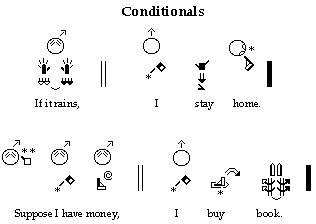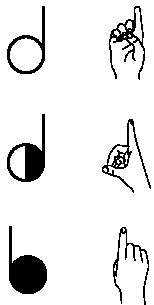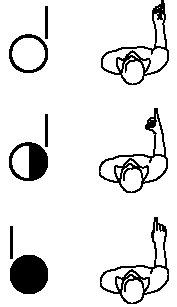Chapter 5, Part One
Writing ASL in SignWriting
History
This section will discuss the way ASL can be written effectively.
A good writing system for a Signed language should have an approximately
one-to-one correspondence between symbol and sign formational
aspect. It should not be difficult to write or read, including
the direction on a page in which it is written...*Footnote
7... It should handle the three-dimensionality of signing.
SignWriting will be discussed in detail as the strongest choice
for a standard ASL writing system.
*Footnote 7:
Boustrophedon is probably not an option, but writing from top
to bottom, similar to Chinese, seems an effective way of writing
ASL.
Although not all of the people who have worked on inventing writing
systems for signed languages have been linguists, almost all
proposed systems make an attempt at capturing the phonemic or
cheremic...*Footnote 8... characteristics
of Sign.
*Footnote 8: A chereme refers to the basic
linguistic unit of sign language (see Matthews 1997: 112).
The systems which rely on arbitrary symbols to represent the
sign formational aspects, like handshape, movement and location,
are less effective because they are more difficult to remember...*Footnote 9: See Appendix B for Stokoe
Notation.
These systems, which often use a combination of letters and
symbols found on a keyboard to represent the formational aspects,
have the advantage of being easy to type or write once the meanings
behind the familiar symbols are learned. However, these systems
do not capture the three dimensional quality of sign language.
SignWriting is not difficult to remember because the pieces which
make up any given written sign are somewhat iconic, and it is
useful across sign languages because its parts have "phonetic"
qualities. It could be considered a notational system for Signed
languages similar to the International Phonetic Alphabet (IPA)
and its capability to represent any language.
There are specific features of Signed languages which call for
the creation of a different conception of writing. ASL will be
considered here and the effectiveness of SignWriting at handling
these features will be discussed. The most obvious feature which
makes a signed language distinct from spoken language is its
medium. When writing English, intonation, quality and the tone
of voice may not be well-represented. Punctuation aids in distinguishing
questions from statements, but writing is usually open to a great
deal of interpretation when read aloud. Similarly, some details
of signing will naturally be left out when written. It is important
to distinguish what in a signed utterance must be written to
preserve meaning and what can be left to the reader's interpretation.
The idea of writing ASL is controversial to some, but people
have been trying to write it since William Stokoe first attempted
linguistic analysis on the communication system used at Gallaudet
in the 1960's. Stokoe realized that the students were employing
language as opposed to gestures when they signed. He was the
first person to analyze ASL linguistically and created a notation
system to write it. In his first linguistic text on ASL, A
Dictionary of American Sign Language on Linguistic Principles,
he divided American Sign Language into the signed equivalent
of "phonemes." His parameters included handshape, location
and movement and he created symbols with which to write fifty-five
sign "phonemes." His system was intended for use in
linguistic analysis, not for practical writing among ASL users
and there was never a movement to use it for written communication...*Footnote 10: See Appendix B for Stokoe
Notation.
SignWriting was invented by Valerie Sutton and several Deaf
signers in 1974 in Denmark. In the United States, over the next
ten years, Sutton worked to promote SignWriting, presenting at
the National Symposium on Sign Language Research and Teaching,
in Chicago in 1977, publishing texts and papers in SignWriting
and leading workshops teaching the system. From 1981 to 1984
Sutton published the SignWriter Newspaper. After working on several
technical manuals, the Deaf Action Committee published their
newsletter which was mailed to around 7,000 people twice a year
from 1991 to 1996. Since then, the SignWriter Newsletter has
been published on the Internet twice a year at https://www.signwriting.org.
SignWriting is currently used in fourteen countries. The main
attractions of this system are its universality, the fact that
it can be used to write any Signed language and the fact that
its creators have developed a computer program to ease its writing.
The pieces that are used in SignWriting to create any number
of signs, including new lexical items, can describe each parameter,
including handshape, movement, location, palm orientation or
non-manual sign. SignWriting is made up of over 600 symbols which
can describe all of these parameters as well as palm orientation
and non-manual signs. For example, the handshape in which the
thumb, index and middle fingers are extended is used in many
signs in which its shape alone holds no morphological value,
but this handshape can signify the number three. In one sign
which makes use of this handshape, "lousy," the thumb
touches the nose and moves away from the face in a downward arc.
In that sign, the handshape has no morphological value. Signing
"week," "month," or "age" with
this same handshape, as opposed to with a basic "1"
handshape (a closed hand with an extended forefinger), would
inflect each lexical item respectively for number (i.e., "three
weeks" versus "one week" etc.).
SignWriting treats these morphological inflections descriptively,
just as it deals with all signs. If anything, SignWriting currently
over-accounts for sign formational aspects by including too much
detail. For example, SignWriting has a way to signify right or
left shoulder forward, lowered or raised, and a great deal of
detail regarding head position. SignWriting can also deal with
the problems of inflected adjectives, through dynamic symbols
which signify speed or quality of a movement. Classifiers are
usually handshapes in ASL which are used to establish a person
or an object in the signing space and can be referred to continuously
throughout a conversation. SignWriting makes use of a tension
symbol to signify classifiers.
Although there are over six hundred SignWriting symbols used
to represent all the various handshapes, movements, locations
and necessary details to pictorially represent a signing person,
there are only ten groups of handshapes, based on which fingers
are used in a handshape. In each of these groups there can be
from four to over ten different base handshapes. Each of those
base handshapes can be written six different ways depending on
palm orientation and location in the signing space...*Footnote
11: See Appendix
D.
These go beyond what is necessary to distinguish signs at
a cheremic level but this is why SignWriting is used for
over ten different Signed languages world wide. What makes this
system particularly easy to learn is its iconicity. One need
only learn the conventions for drawing the symbol of a hand and
hand placement in the signing space, (palm-in, palm-out, palm-side,
arm out) to apply this knowledge fairly consistently to most
of the symbols. The facial expression symbols are also transparent.
Only the movement and some of the body location symbols might
require some study to master.
One of the most exciting developments in this movement has been
the recent literacy project. Although SignWriting is used in
other countries, like Denmark and Nicaragua, to teach deaf children
in their native Signed languages, it has not been used in the
United States in this way. The literacy project was launched
recently and there are currently four school systems getting
ready to teach their deaf students to use this writing system.
Most Deaf people are averse to writing ASL when they are first
presented with the idea, claiming that it is unnecessary. They
are usually threatened by the new idea and suspicious of it.
However, once they become familiar with SignWriting, they seem
to find it an invaluable tool for expression and education.
Facial expressions are always present in the signing of ASL.
Quite often the placement of the brow and mouth position are
distinctive in that changing the facial expression would change
the meaning of the sign. Furthermore, when the facial expression
is not of direct importance to the meaning of a particular sign,
it is likely to function grammatically. For example, when a clause
is marked by raised eyebrows a conditional statement is implied
and the observer expects the condition to follow. The same clause
signed with eyebrows furrowed would be in regular question form.
The English sentence, "If it rains tomorrow, the game will
be canceled" relies on non-manual signs for expression in
ASL. Without the necessary raised eyebrows, a head tilt and possibly
a short pause, the signed utterance could mean either, "It
will rain tomorrow and the games will be canceled" or "Will
it rain tomorrow? The game will be canceled." SignWriting
handles this in the following way. See Figure 5.
 Figure 5...*Footnote 12...
Figure 5...*Footnote 12...
Writing a Conditional Clause
*Footnote 12: From Lessons in SignWriting
by Valerie Sutton. If not otherwise noted, all figures are from
this source with permission by Valerie Sutton.
Without the raised eyebrows, indicated above in SignWriting,
the sentence would be ambiguous.
Most writing systems do not handle facial expressions at all.
SignWriting can handle them but excludes them from structures
in which they mark the tone of the utterance as opposed being
integral to the inherent meaning of it. Furthermore, while the
method for writing facial expressions is simple, the shorthand
seems to exclude them most of the time because either context
elucidates the correct facial expression, or the note-taker's
memory will suffice for rewriting a passage in full SignWriting
later. The shorthand is usually used to write quickly what someone
is signing and is often revisited later to be fleshed out on
computer.
The three dimensional aspect of signing is difficult to capture
with a linear writing system like English in which each symbol
follows the next. Instead, a sign should be presented as a whole
entity with all its features simultaneously represented just
as they simultaneously occur. SignWriting is particularly well
equipped to handle this aspect of all Signed languages. It is
written from the signer's perspective and read in the same way.
This is in keeping with the way ASL is signed. For example, when
describing an object, the signer will do so from his or her point
of view, not the point of view of the observer. Furthermore,
when giving directions in sign language, the signer will also
give them from his or her own point of view if a separate reference
point is lacking. See figure 6.
 Figure 6:
Figure 6:
Giving Directions (Smith, Lentz and Mikos 1988)
The way SignWriting handles three dimensional space is through
the coloring of a given piece of any sign. For example, a handshape
has a base form in SignWriting. See Figure 7.
 Figure 7:
Figure 7:
Base Handshape
This hand is held vertically,
parallel to the wall and with the palm in.
But, whether it is colored in, left blank, half-colored in or
open between the hand and fingers tells the position of the hand
in three dimensional space. See Figures 8 and 9.
 Figure 8:
Figure 8:
Modifying the Base Handshape

 Figure 9:
Figure 9:
Modifying the Base Handshape
This is an integral part of what makes SignWriting
more effective than other writing systems. Signers often use
their sign space, a restricted area in front of their bodies,
to set up referents which they will then refer to over the course
of their discussion of those people or objects. It is much easier
to observe and keep track of this phenomenon using SignWriting
compared with other writing systems.
One problem with writing ASL involves adverbs or inflected adjectives.
Unlike English intonation, sometimes used to stress an adjective,
"stress" on an adjective in ASL inflects the sign.
For example, the word "fast" can be said with lengthening
of the fricative /f/ and the first vowel /ae/ in English to mean
"very fast." This is usually not represented in writing.
Sometimes italics or underlining suggest a certain stressing
of a word but the exact kind of stressing is still open to interpretation.
In ASL, the duration of the sign, whether it is lengthened or
signed more quickly than usual, depends on and reflects the meaning
of the inflection. This means that while it is appropriate in
English to say "really fast" or "incredibly fast,"
ASL adverbs use inflections most often based on movement change
when signing an adjective. SignWriting includes symbols for such
movements...*Footnote 13...
*Footnote 13: SignWriting symbols for
"fast": "Very fast":
...continue
Chapter 5, Part 2...
|




